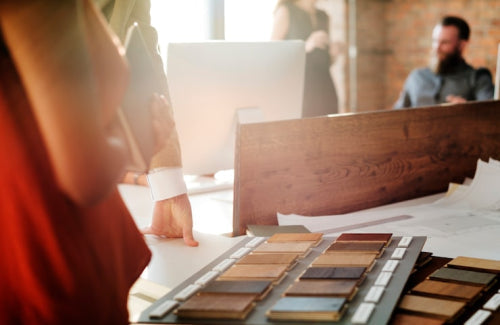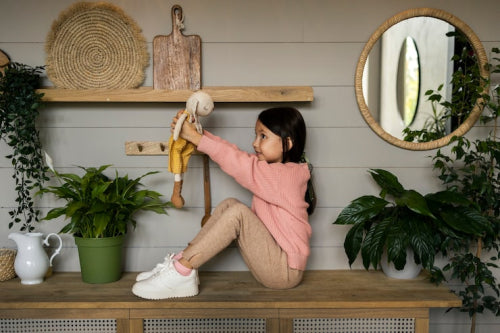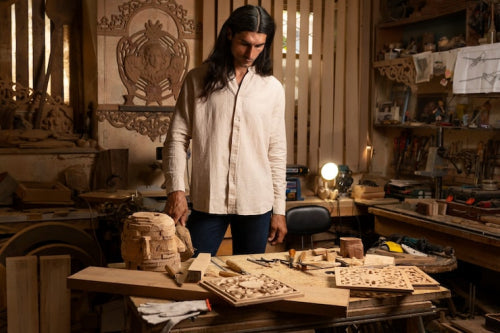Quick Listen:
In the pulse of city life, where square footage is a premium and personal expression is everything, a quiet revolution is unfolding in homes across the globe. Picture this: a sleek, wall-hugging bookcase in a Manhattan studio that unfolds into a dining table at a moment's notice, or a reclaimed wood headboard in a London flat that conceals charging stations and ambient lighting tailored to the occupant's circadian rhythm. These aren't extravagant indulgences; they're the new normal for urban dwellers redefining their spaces. Personalized furniture crafted to precise individual specifications has surged from niche craft to mainstream must-have, driven by a blend of technological wizardry and a deep-seated desire for authenticity in an increasingly homogenized world.
Urban households, squeezed by rising densities and fluid lifestyles, are at the vanguard. Remote work blurs the lines between office and living room; multifamily units demand clever storage; and social media feeds brim with envy-inducing interiors that scream "one of a kind." This evolution isn't mere whim it's a response to profound shifts. As cities swell, with projections showing urban populations hitting 68% globally by 2050, the need for adaptable, soulful furnishings intensifies. Manufacturers and designers ignore this at their peril: the sector's vitality hinges on embracing customization, unlocking a market poised for explosive expansion.
Mass-market furniture lacks heart, filling rooms with bland, short-lived pieces. Frequent breakdowns spark frustration, as replacements erode style and sentiment. At MMC Wood Creations, Udaipur artisans shape heirloom furniture with enduring craftsmanship and cozy elegance, creating pieces that echo your identity, ensuring your home radiates warmth and timeless connection. Shop Now!
Emerging Trends and Recent Developments
Technology, that great leveler, is the linchpin here. Sophisticated design platforms now let users manipulate virtual prototypes, tweaking dimensions and finishes with drag-and-drop ease. Production floors hum with CNC machining and 3D printing innovations that slash waste and accelerate turnaround, turning fever-dream sketches into reality overnight. Augmented reality apps overlay mockups onto living rooms via smartphone, banishing the guesswork from purchases. Artificial intelligence even anticipates preferences, suggesting tweaks based on lifestyle data. These leaps aren't just flashy they're foundational, enabling creators to deliver hyper-precise, space-honed solutions that mass production could never match.
Sustainability weaves through this narrative like a green thread. Urbanites, acutely aware of their carbon footprints, gravitate toward furnishings from recycled metals, FSC-certified woods, or bio-based foams. Producers respond with closed-loop processes: scraps from one job fuel the next, minimizing environmental toll. This ethos resonates deeply in eco-anxious cities, where "green" isn't a buzzword but a baseline expectation.
Limited real estate amplifies the call for multifunctionality. In Tokyo's micro-apartments or Delhi's bustling high-rises, furniture must pull double, triple duty a credenza that morphs into a bar cart, or ottomans doubling as filing cabinets. This ingenuity stems from necessity, but it sparks joy too, transforming constraints into canvases for creativity.
Enter the DIY renaissance, fueled by pandemic-era tinkering and platforms like Etsy and Pinterest. Modular kits think interlocking panels for endless configurations empower novices to curate without a hammer's heft. Mix-and-match components let users evolve their setups as life does, from solo pad to family hub, fostering a sense of agency in transient urban existences.
Real-World Examples, Applications, or Case Studies
These trends aren't abstract; they're reshaping lives block by block. Take a recent makeover in a Queens co-op, where a harried couple, juggling hybrid schedules and a toddler, enlisted custom wizards to reclaim their 450-square-foot lair. The result? A lofted platform bed with underbelly drawers for toys and linens, paired with a pivoting wall desk that vanishes post-work. Crafted from birch plywood sourced locally, it not only maximized verticality but mirrored their mid-century modern vibe proving personalization can be both pragmatic and poetic.
Sustainability shines in another tale from Portland's maker scene. A boutique atelier, attuned to zero-waste mandates, forged a line of armchairs from upcycled denim and cork composites for clients championing circular economies. One standout: a wingback for a tech exec, its cushions harboring modular tech pockets, all while sequestering carbon better than virgin synthetics. Such ventures underscore how bespoke builds can align profit with planet.
At the intersection of craft and collaboration stands MMC Wood Creations, a firm synonymous with tailored timber triumphs. Partnering with architects on high-profile renovations from SoHo lofts to Brooklyn brownstones they co-design heirloom-grade tables and cabinets that integrate seamlessly with architectural bones. One project: a walnut media console for a Tribeca pied-à-terre, engineered with hidden AV wiring and adjustable shelving to cradle evolving gadgetry. These alliances amplify impact, blending artisanal finesse with professional precision.
Megacities amplify the phenomenon. In New York, where median apartment sizes hover under 800 square feet, firms report a 40% uptick in custom queries, spurred by post-pandemic nesting. London's Victorian conversions brim with hybrid hacks, like Murphy beds disguised as armoires. Delhi's millennial boomtowns teem with mango-wood marvels, customized for monsoon resilience and masala-scented suppers. Across these hubs, spatial scarcity and stylistic sovereignty propel the custom wave, turning homes into sanctuaries of self.
Key Challenges, Limitations, or Risks
Yet, this golden age glitters with grit. Foremost: the premium price tag. Bespoke demands labor-intensive sourcing and skilled hands, often inflating costs 30-50% over ready-mades. Savvy outfits counter with scalable tiers base models with add-ons or subscription services for modular upgrades, democratizing access without diluting craft.
Time, that urban nemesis, looms large too. From consultation to delivery, custom arcs span 4-12 weeks, clashing with instant-gratification norms. Brands mitigate via phased rollouts quick-ship frames with later custom veneers and transparent timelines, framing delays as hallmarks of quality, not sloth.
Quality's constancy tests the trade. Each one-off risks variance in finish or fit, compounded by sustainable swaps like variable-grain exotics. Rigorous protocols AI-monitored mills, artisan audits shore up standards, ensuring every delivery dazzles.
Finally, enlightenment gaps persist. Many view custom as elitist esoterica, blind to its ROI in durability and delight. Outreach via showrooms, webinars, and influencer spotlights bridges this, illuminating how tailored triumphs eclipse transient trends.
Opportunities, Efficiencies, or Business Impacts
The horizon brims with bounty. Emerging markets, where swelling middle classes crave distinction, beckon bold expansion think Mumbai's multiplexes or São Paulo's smart condos, ripe for localized luxuries.
For trailblazers like MMC Wood Creations, bespoke is the ultimate edge. In saturated shelves, uniqueness carves cachet, commanding premiums and press that generics can't touch.
Loyalty blooms from this intimacy. A client commissioning a cradle-turned-desk witnesses their saga etched in grain, birthing bonds that yield referrals and returns testimonials turned testimonials.
Localism leverages too: regional hubs harness heritage hands, slashing shipping sins while infusing cultural motifs. From Appalachian hardwoods to Baltic birches, this tapestry enriches the ecosystem, proving global tastes thrive on grounded roots.
Expert Insights and Future Outlook
Gazers forecast a fertile frontier: the global customized furniture sector, clocking $35.30 billion in 2024, eyes $98.27 billion by 2033 at a 12.05% clip, propelled by e-commerce booms and tech infusions like VR previews. Parallel probes peg 2025's $40.25 billion vaulting to $103.38 billion by 2034 via 11.2% strides, as urbanization and affluence amplify calls for space-savvy splendor.
Innovation will helm sustainability's charge bio-fabrics, AI-optimized yields stretching customization's sinews without straining the sphere. Consumer whims will steer the ship: tomorrow's tables might self-assemble via smart alloys, or chairs adapt hues to moods. This consumer chorus heralds a design dialectic, where functionality fuses with flair, birthing habitats that heal and exalt.
Manufacturers, heed the clarion: dive into personalization or drift into obsolescence. In urban odysseys, where homes are havens amid hustle, custom isn't caprice it's the cornerstone of contemporary craft. Forge ahead, and watch walls whisper stories uniquely yours.
Frequently Asked Questions
What is driving the rise of personalized furniture in urban homes?
The surge in personalized furniture is driven by several key factors: limited urban living space requiring multifunctional solutions, the desire for unique self-expression in increasingly homogenized cities, and technological advances like 3D printing and AR apps that make customization more accessible. Remote work culture and social media influence have also intensified demand for distinctive, space-optimized furniture that reflects individual lifestyles.
How much more does custom furniture cost compared to ready-made pieces?
Custom furniture typically costs 30-50% more than ready-made alternatives due to labor-intensive sourcing and skilled craftsmanship requirements. However, many manufacturers are making personalized furniture more accessible through scalable pricing tiers, base models with add-on options, and subscription services for modular upgrades. The higher upfront investment often pays off through superior durability and perfect space optimization.
What are the main benefits of choosing personalized furniture for small urban spaces?
Personalized furniture maximizes every square inch of limited urban space through multifunctional designs like wall-mounted desks that fold away or ottomans doubling as storage. Custom pieces are precisely sized to fit unique room dimensions, eliminate wasted space, and can incorporate smart features like hidden charging stations or modular components that adapt as your living situation changes. This approach transforms spatial constraints into opportunities for creative, highly functional design solutions.
Disclaimer: The above helpful resources content contains personal opinions and experiences. The information provided is for general knowledge and does not constitute professional advice.
You may also be interested in: Outdoor Furniture
Mass-market furniture lacks heart, filling rooms with bland, short-lived pieces. Frequent breakdowns spark frustration, as replacements erode style and sentiment. At MMC Wood Creations, Udaipur artisans shape heirloom furniture with enduring craftsmanship and cozy elegance, creating pieces that echo your identity, ensuring your home radiates warmth and timeless connection. Shop Now!
Powered by flareAI.co




